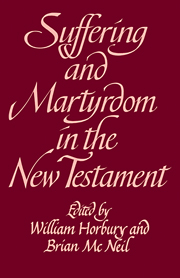 Suffering and Martyrdom in the New Testament
Suffering and Martyrdom in the New Testament Book contents
- Frontmatter
- Contents
- Abbreviations
- G. M. Styler and the Cambridge New Testament Seminar
- 1 Introduction
- 2 Did Jesus teach that his death would be vicarious as well as typical?
- 3 Imitatio Christi and the Lucan Passion narrative
- 4 The persecution of Christians in John 15: 18–16: 4a
- 5 Interchange and suffering
- 6 On the interpretation of Colossians 1: 24
- 7 Preparation for the perils of the last days: 1 Thessalonians 3:3
- 8 Maintaining the testimony of Jesus: the suffering of Christians in the Revelation of John
- 9 Martyrdom and inspiration
- 10 Suffering and martyrdom in the Odes of Solomon
- 11 Suffering and messianism in Yose ben Yose
- 12 What might martyrdom mean?
- Index of authors
- Index of references
- Index of subjects
2 - Did Jesus teach that his death would be vicarious as well as typical?
Published online by Cambridge University Press: 26 February 2010
- Frontmatter
- Contents
- Abbreviations
- G. M. Styler and the Cambridge New Testament Seminar
- 1 Introduction
- 2 Did Jesus teach that his death would be vicarious as well as typical?
- 3 Imitatio Christi and the Lucan Passion narrative
- 4 The persecution of Christians in John 15: 18–16: 4a
- 5 Interchange and suffering
- 6 On the interpretation of Colossians 1: 24
- 7 Preparation for the perils of the last days: 1 Thessalonians 3:3
- 8 Maintaining the testimony of Jesus: the suffering of Christians in the Revelation of John
- 9 Martyrdom and inspiration
- 10 Suffering and martyrdom in the Odes of Solomon
- 11 Suffering and messianism in Yose ben Yose
- 12 What might martyrdom mean?
- Index of authors
- Index of references
- Index of subjects
Summary
Christians and many non-Christians agree that Jesus' death was a model of self-sacrificing love. They hold that his words, his life, and his death formed a seamless robe: he taught love; he acted out love; and he died displaying love. The non-Christians who hold this view of Jesus do not see any reason to become Christians, for they reject the notion that Jesus' death was a sacrifice made on their behalf. Self-sacrifice, yes; but sacrifice, no.
What is particularly interesting is that many Christians, too, wish to eliminate the idea that Jesus' death was a sacrifice for others. I well remember the long and sensitive discussions that went on in Professor Moule's Seminar in 1968–9 and again in 1974–5 about just this point. Geoffrey Styler defended the retention of the term ‘sacrifice’ by patiently insisting that the idea of sacrifice was the only term that applied directly to the work of Christ (for all the other terms applied to mankind's situation before and after the work of redemption); while Professor Moule, equally patient, argued that sacrificial language should be left behind.
To leave sacrificial language behind is not necessarily to endorse a merely exemplarist interpretation of the death of Christ. Some other way may well be found for emphasising the centrality of Christ's work than saying that he offered his life in sacrifice to the Father. Jesus' death can be held up as an archetype of what happens when perfect love meets evil, and believers can be invited to leave self behind and to adopt this archetypal love.
- Type
- Chapter
- Information
- Suffering and Martyrdom in the New TestamentStudies presented to G. M. Styler by the Cambridge New Testament Seminar, pp. 9 - 27Publisher: Cambridge University PressPrint publication year: 1981
